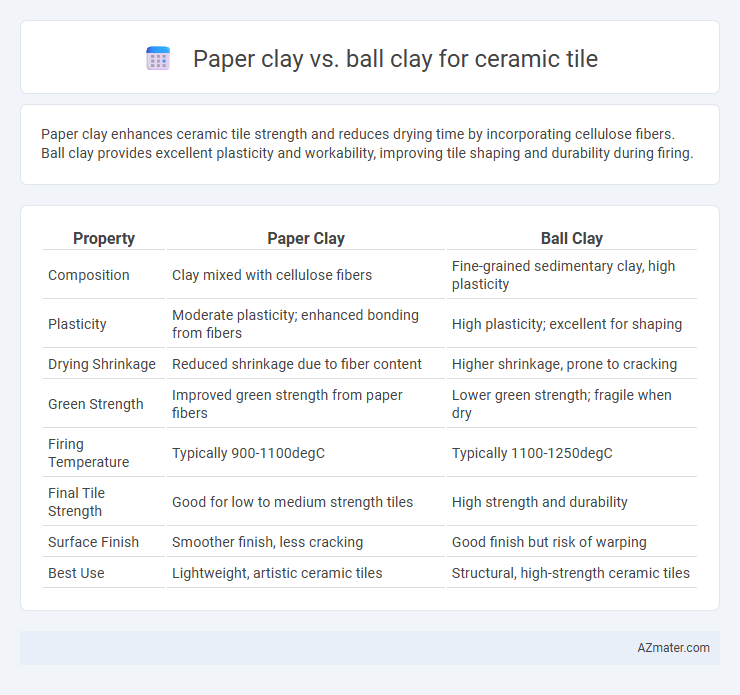Paper clay enhances ceramic tile strength and reduces drying time by incorporating cellulose fibers. Ball clay provides excellent plasticity and workability, improving tile shaping and durability during firing.
Table of Comparison
| Property | Paper Clay | Ball Clay |
|---|---|---|
| Composition | Clay mixed with cellulose fibers | Fine-grained sedimentary clay, high plasticity |
| Plasticity | Moderate plasticity; enhanced bonding from fibers | High plasticity; excellent for shaping |
| Drying Shrinkage | Reduced shrinkage due to fiber content | Higher shrinkage, prone to cracking |
| Green Strength | Improved green strength from paper fibers | Lower green strength; fragile when dry |
| Firing Temperature | Typically 900-1100degC | Typically 1100-1250degC |
| Final Tile Strength | Good for low to medium strength tiles | High strength and durability |
| Surface Finish | Smoother finish, less cracking | Good finish but risk of warping |
| Best Use | Lightweight, artistic ceramic tiles | Structural, high-strength ceramic tiles |
Understanding Paper Clay and Ball Clay
Paper clay contains cellulose fibers that improve drying strength and reduce cracking, making it ideal for intricate ceramic tile designs requiring flexibility and reduced shrinkage. Ball clay is a fine-grained, highly plastic kaolinite-rich material known for its excellent plasticity and vitrification properties, providing strength and durability in ceramic tiles. Understanding the distinct compositions and functional benefits of paper clay versus ball clay helps manufacturers optimize tile performance and aesthetic qualities.
Composition Differences Between Paper Clay and Ball Clay
Paper clay contains a high percentage of fibers, typically cellulose, which enhances its drying and firing properties, while ball clay is primarily composed of fine-grained kaolinite, mica, and quartz, contributing to its plasticity and strength. The organic fiber content in paper clay reduces shrinkage and improves workability, whereas ball clay's mineral composition provides the necessary plasticity and whiteness ideal for ceramic tile formation. These compositional differences impact tile durability, drying time, and surface finish, making paper clay suitable for lightweight and textured tiles and ball clay preferred for structural robustness and smooth finishes.
Physical Properties Comparison
Paper clay exhibits lower shrinkage and higher porosity compared to ball clay, which enhances its drying flexibility and reduces cracking in ceramic tiles. Ball clay features finer particle size and higher plasticity, providing superior workability and green strength but leading to greater shrinkage during firing. The combination of these physical properties determines the tile's durability, surface finish, and resistance to warping.
Workability for Tile Production
Paper clay offers enhanced workability for ceramic tile production due to its lightweight composition and plasticity, allowing finer shaping and reduced drying time. Ball clay provides superior plasticity and strength, improving the tile's structural integrity during forming but requires careful moisture management to prevent cracking. Combining both clays can optimize workability, balancing ease of molding with mechanical strength for efficient tile manufacturing.
Firing Behaviors: Paper Clay vs Ball Clay
Paper clay exhibits lower shrinkage and reduced cracking during firing compared to ball clay, due to its high fiber content and porous structure. Ball clay provides excellent plasticity and workability but tends to experience greater shrinkage and potential warping at high firing temperatures. The firing behavior of paper clay ensures improved dimensional stability, while ball clay contributes to the tile's strength and vitrification in ceramic tile production.
Strength and Durability of Ceramic Tiles
Paper clay enhances ceramic tile strength and durability by incorporating cellulose fibers that create a flexible, lightweight structure, reducing drying and firing cracks. Ball clay, known for its high plasticity and fine particle size, improves green strength and plasticity but may cause more shrinkage and potential warping during firing. Combining paper clay's fiber reinforcement with ball clay's plasticity often results in ceramic tiles with superior mechanical strength and long-term durability.
Shrinkage and Warping Considerations
Paper clay exhibits lower shrinkage rates compared to ball clay, reducing the risk of warping during drying and firing processes in ceramic tiles. Ball clay, known for its fine particle size and high plasticity, tends to shrink more significantly, which can cause greater warping and dimensional instability. Choosing paper clay can enhance tile durability by minimizing deformation and maintaining consistent tile dimensions.
Surface Finish and Glazing Results
Paper clay enhances surface finish in ceramic tiles by providing a smoother, more uniform texture due to its fiber content, which reduces cracking and warping during drying. Ball clay offers excellent plasticity and particle bonding, resulting in a dense, strong body that supports glossy and even glazing outcomes. Tiles made with paper clay often exhibit a matte or soft satin surface, while ball clay-based tiles achieve higher gloss and vibrant glaze adherence.
Environmental Impact and Sustainability
Paper clay significantly reduces environmental impact in ceramic tile production due to its use of recycled paper fibers, lowering the need for virgin clay extraction and minimizing landfill waste. Ball clay, while prized for its plasticity and strength, often involves intensive mining processes that lead to habitat disruption and higher carbon emissions. Using paper clay supports sustainability by conserving natural resources and promoting circular economy practices within the ceramics industry.
Best Applications for Each Clay Type
Paper clay enhances ceramic tile production by improving workability and reducing drying shrinkage, making it ideal for intricate designs and hand-built tiles. Ball clay offers superior plasticity and strength, suitable for mass production of durable, high-quality tiles requiring consistent shaping and firing. Selecting paper clay benefits artistic, custom tiles, while ball clay optimizes performance in commercial tile manufacturing.

Infographic: Paper clay vs Ball clay for Ceramic tile
 azmater.com
azmater.com